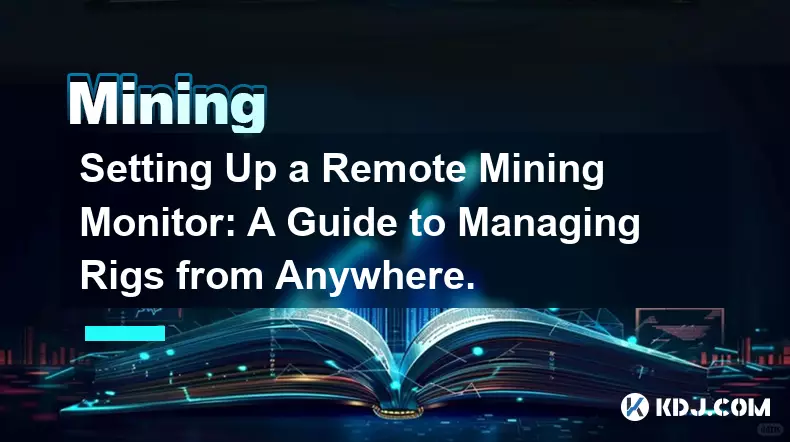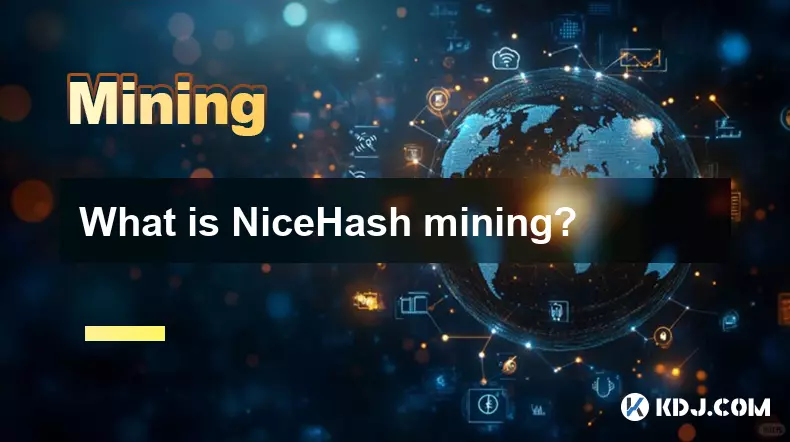-
 bitcoin
bitcoin $100977.009184 USD
-2.05% -
 ethereum
ethereum $3282.009150 USD
-3.23% -
 tether
tether $0.999813 USD
-0.02% -
 xrp
xrp $2.208254 USD
-4.89% -
 bnb
bnb $951.411089 USD
0.55% -
 solana
solana $155.761205 USD
-2.84% -
 usd-coin
usd-coin $1.000217 USD
0.02% -
 tron
tron $0.284475 USD
-1.28% -
 dogecoin
dogecoin $0.162363 USD
-1.53% -
 cardano
cardano $0.533988 USD
-0.47% -
 hyperliquid
hyperliquid $39.174339 USD
-3.22% -
 chainlink
chainlink $14.724828 USD
-1.16% -
 bitcoin-cash
bitcoin-cash $477.297986 USD
-1.28% -
 zcash
zcash $554.227426 USD
17.30% -
 ethena-usde
ethena-usde $0.998995 USD
-0.03%
Setting Up a Remote Mining Monitor: A Guide to Managing Rigs from Anywhere.
Remote monitoring is essential for crypto mining, enabling real-time oversight of performance, alerts for downtime, energy optimization, and management across distributed locations.
Nov 04, 2025 at 07:54 am

Why Remote Monitoring Is Essential for Modern Crypto Mining
1. The rise of decentralized digital currencies has led to an explosion in mining operations across the globe. As miners seek efficiency and scalability, managing rigs physically at each location is no longer practical. Remote monitoring allows operators to oversee performance, temperatures, hash rates, and power consumption without being on-site.
2. Downtime in mining can lead to direct financial loss. With remote systems, alerts can be triggered instantly when a rig goes offline or experiences hardware failure. This immediate notification enables faster troubleshooting, minimizing revenue disruption.
3. Energy costs are one of the largest expenses in mining. By using remote tools, operators can analyze energy usage patterns over time and adjust settings during off-peak hours. This optimization helps maintain profitability even in volatile market conditions.
4. Geographical diversification of mining farms reduces risks associated with local power outages or regulatory changes. Remote monitoring provides a unified interface to manage multiple locations, ensuring consistent oversight regardless of physical distance.
Key Tools and Software for Remote Mining Management
1. Awesome Miner is widely used for Windows-based setups. It supports integration with ASICs, GPUs, and various mining software like CGMiner and BFGMiner. Its dashboard offers real-time analytics, automation rules, and alert systems via email or SMS.
2. Minerstat provides cloud-based monitoring tailored for both small-scale hobbyists and large farms. It supports major cryptocurrencies including Bitcoin, Ethereum (prior to PoS), and Ravencoin. Users gain access to detailed reports on uptime, rejected shares, and wallet balances.
3. HiveOS is a Linux-based operating system designed specifically for crypto miners. It comes with built-in remote control features accessible through a web browser or mobile app. Configuration updates, reboots, and overclocking profiles can be pushed across all connected rigs simultaneously.
4. For those running custom scripts or open-source solutions, tools like Grafana paired with Prometheus allow full customization of dashboards. These require more technical knowledge but offer granular visibility into every aspect of rig performance.
Setting Up Your First Remote Monitoring System
1. Begin by selecting a stable operating system such as HiveOS or RaveOS, which are optimized for continuous mining operations. Install it on your primary rig or deploy it across multiple units using PXE boot or USB flash drives.
2. Ensure each mining rig has reliable internet connectivity. Use wired Ethernet connections instead of Wi-Fi whenever possible to reduce latency and packet loss that could interfere with data reporting.
3. Register an account with your chosen monitoring platform—whether it’s Minerstat, Awesome Miner, or another service. Follow the setup wizard to link your devices using API keys or unique identifiers provided by the software.
4. Configure alert thresholds for temperature, fan speed, and hash rate deviations. Set up notifications through email, Telegram, or push messages so you’re informed immediately if something falls outside acceptable parameters.
5. Test the system thoroughly by simulating failures—unplug a GPU temporarily or throttle the hash rate—and verify that alerts are received and visible on the dashboard.
Security Considerations When Operating Remotely
1. Exposing mining rigs to the internet increases attack surface. Always use strong passwords and enable two-factor authentication (2FA) on all accounts linked to monitoring platforms.
2. Never expose SSH or RPC ports directly to the public internet. Instead, use secure tunnels via VPNs or tools like Tailscale to create private networks between your device and the mining farm.
3. Regularly update firmware and monitoring software to patch known vulnerabilities. Outdated versions may contain exploits that allow unauthorized access or cryptocurrency theft.
4. Limit user permissions within the monitoring dashboard. If multiple team members need access, assign roles based on responsibility—some may only view stats, while others can issue commands.
Frequently Asked Questions
Can I monitor ASIC miners remotely using the same tools as GPU rigs?Yes, most modern monitoring platforms support both ASIC and GPU miners. Devices from manufacturers like Bitmain, MicroBT, and Innosilicon can be integrated into systems like Minerstat or Awesome Miner by entering their IP addresses and enabling API access.
What happens if my internet connection fails at the mining site?If connectivity drops, the rigs will continue mining locally, but you won’t receive live data or alerts. To mitigate this, consider setting up a backup LTE modem or dual WAN router to maintain communication. Some advanced setups use SMS-based failover alerts triggered by local sensors.
Is it possible to change mining pools remotely?Absolutely. Platforms like HiveOS allow you to switch pools instantly through the web interface. You can also configure fallback pools automatically in case the primary becomes unreachable, ensuring minimal downtime.
Do I need a dedicated server to run remote monitoring software?Not necessarily. Cloud-based services like Minerstat handle backend processing, requiring only a web browser on your end. However, self-hosted solutions such as Zabbix or custom Prometheus instances may require a VPS or physical server for data collection and storage.
Disclaimer:info@kdj.com
The information provided is not trading advice. kdj.com does not assume any responsibility for any investments made based on the information provided in this article. Cryptocurrencies are highly volatile and it is highly recommended that you invest with caution after thorough research!
If you believe that the content used on this website infringes your copyright, please contact us immediately (info@kdj.com) and we will delete it promptly.
- Layer 2 Coins: Will There Be a Potential Explosion by 2026?
- 2025-11-07 16:50:02
- Filecoin, ICP, and the AI Infrastructure Renaissance: Is History Repeating?
- 2025-11-07 16:50:02
- Bitcoin's Wild Ride: Surges, Zeros, and the Search for Stability
- 2025-11-07 17:05:01
- XRP, Bitcoin, and the Rally: What's the Deal, New York?
- 2025-11-07 17:25:01
- Filecoin, DePIN, and a Technical Breakout: What's the Buzz?
- 2025-11-07 17:05:01
- Bitcoin Wobbles: ETF Outflows and the $100K Line in the Sand
- 2025-11-07 18:05:01
Related knowledge

What is the block reward in mining?
Nov 06,2025 at 12:35am
Understanding Block Rewards in Cryptocurrency Mining1. The block reward is the incentive miners receive for successfully validating and adding a new b...

How do mining algorithms work?
Nov 06,2025 at 04:59am
Mining Algorithms and Their Role in Blockchain Networks1. Mining algorithms serve as the backbone of blockchain consensus mechanisms, ensuring that tr...

What is NiceHash mining?
Nov 06,2025 at 07:40am
NiceHash mining refers to the process of renting out computational power to individuals or organizations seeking to mine cryptocurrencies without owni...

Does an antivirus program affect mining?
Nov 05,2025 at 09:29pm
Understanding Decentralized Exchanges in the Crypto Ecosystem1. Decentralized exchanges (DEXs) operate without a central authority, allowing users to ...

What is the history of Bitcoin mining?
Nov 05,2025 at 08:15pm
Within the fast-moving world of cryptocurrency, new developments emerge daily, reshaping how investors, developers, and institutions interact with dig...

How is the energy consumption of mining justified?
Nov 05,2025 at 10:20pm
Energy Consumption in Cryptocurrency Mining1. The energy consumption associated with cryptocurrency mining has drawn significant attention from enviro...

What is the block reward in mining?
Nov 06,2025 at 12:35am
Understanding Block Rewards in Cryptocurrency Mining1. The block reward is the incentive miners receive for successfully validating and adding a new b...

How do mining algorithms work?
Nov 06,2025 at 04:59am
Mining Algorithms and Their Role in Blockchain Networks1. Mining algorithms serve as the backbone of blockchain consensus mechanisms, ensuring that tr...

What is NiceHash mining?
Nov 06,2025 at 07:40am
NiceHash mining refers to the process of renting out computational power to individuals or organizations seeking to mine cryptocurrencies without owni...

Does an antivirus program affect mining?
Nov 05,2025 at 09:29pm
Understanding Decentralized Exchanges in the Crypto Ecosystem1. Decentralized exchanges (DEXs) operate without a central authority, allowing users to ...

What is the history of Bitcoin mining?
Nov 05,2025 at 08:15pm
Within the fast-moving world of cryptocurrency, new developments emerge daily, reshaping how investors, developers, and institutions interact with dig...

How is the energy consumption of mining justified?
Nov 05,2025 at 10:20pm
Energy Consumption in Cryptocurrency Mining1. The energy consumption associated with cryptocurrency mining has drawn significant attention from enviro...
See all articles










































































